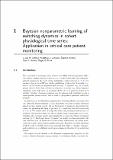| dc.contributor.author | Lehman, Li-Wei | |
| dc.contributor.author | Johnson, Matthew James | |
| dc.contributor.author | Nemati, Shamim | |
| dc.contributor.author | Adams, Ryan P. | |
| dc.contributor.author | Mark, Roger G | |
| dc.date.accessioned | 2020-08-14T12:02:31Z | |
| dc.date.available | 2020-08-14T12:02:31Z | |
| dc.date.issued | 2015 | |
| dc.identifier.uri | https://hdl.handle.net/1721.1/126581 | |
| dc.description.abstract | Introduction The time series of vital signs, such as heart rate (HR) and blood pressure (BP), can exhibit complex dynamic behaviors as a result of internally and externally induced changes in the state of the underlying control systems (Peng et al. 1995; Ivanov et al. 1999; Costa et al. 2002). For instance, time series of BP can exhibit oscillations on the order of seconds (e.g., due to the variations in sympathovagal balance), to minutes (e.g., as a consequence of fever, blood loss, or behavioral factors), to hours (e.g., due to humoral variations, sleep-wake cycle, or circadian effects) (Mancia 2012; Parati et al. 2013). A question of interest is whether “similar” dynamical patterns can be automatically identified across a heterogeneous patient cohort, and be used for prognosis of patients' health and progress. In this work, we present a Bayesian nonparametric switching Markov processes framework with conditionally linear dynamics to learn phenotypic dynamic behaviors from vital sign time series of a patient cohort, and use the learned dynamics to characterize the changing physiological states of patients for critical-care bed-side monitoring (Lehman et al. 2012, 2013, 2014a; Nemati 2012). We assume that although the underlying dynamical system may be nonlinear and nonstationary and the stochastic noise components can be non-Gaussian, the dynamics can be approximated by a collection of linear dynamical systems (Nemati 2012; Nemati et al. 2012). Each such linear “dynamic” (or mode) is a time-dependent rule that describes how the future state of the system evolves from its current state, centered around a given system equilibrium point. Therefore, an ideal algorithm would be able to identify time series segments that follow a “similar” dynamic, and would switch to a different mode upon a change in the state of the underlying system. We explore several variants of the Bayesian nonparametric approach to discovery of shared dynamics among patients via switching Markov processes: hierarchical Dirichlet process (HDP) autoregressive hidden Markov model (HDP-AR-HMM) (Teh et al. 2006; Fox et al. 2008), an explicit-duration HDP-based hidden semi-Markov model (HDP-AR-HSMM) (Johnson & Willsky 2013a), and the beta process autoregressive HMM (BP-AR-HMM) (Fox 2009; Fox et al. 2009, 2014). | en_US |
| dc.description.sponsorship | National Institutes of Health (U.S.) (Grant R01-EB001659) | en_US |
| dc.description.sponsorship | National Institute of Biomedical Imaging and Bioengineering (Grant R01GM10498) | en_US |
| dc.description.sponsorship | United States. Defense Advanced Research Projects Agency. Young Faculty Award (Grant 66001-12-1-4219) | en_US |
| dc.language.iso | en | |
| dc.publisher | Cambridge University Press | en_US |
| dc.relation.isversionof | 10.1017/CBO9781139941433.012 | en_US |
| dc.rights | Creative Commons Attribution-Noncommercial-Share Alike | en_US |
| dc.rights.uri | http://creativecommons.org/licenses/by-nc-sa/4.0/ | en_US |
| dc.source | Other repository | en_US |
| dc.title | Bayesian nonparametric learning of switching dynamics in cohort physiological time series: Application in critical care patient monitoring | en_US |
| dc.type | Article | en_US |
| dc.identifier.citation | Lehman, Li-wei H. et al. “Bayesian nonparametric learning of switching dynamics in cohort physiological time series: Application in critical care patient monitoring.” Working Paper - Harvard University OpenScholar, vol. 344581, 2015 © 2015 The Author(s) | en_US |
| dc.contributor.department | Massachusetts Institute of Technology. Institute for Medical Engineering & Science | en_US |
| dc.relation.journal | Working Paper - Harvard University OpenScholar | en_US |
| dc.eprint.version | Author's final manuscript | en_US |
| dc.type.uri | http://purl.org/eprint/type/JournalArticle | en_US |
| eprint.status | http://purl.org/eprint/status/PeerReviewed | en_US |
| dc.date.updated | 2019-10-09T15:19:59Z | |
| dspace.date.submission | 2019-10-09T15:20:00Z | |
| mit.journal.volume | 344581 | en_US |
| mit.metadata.status | Complete | |
